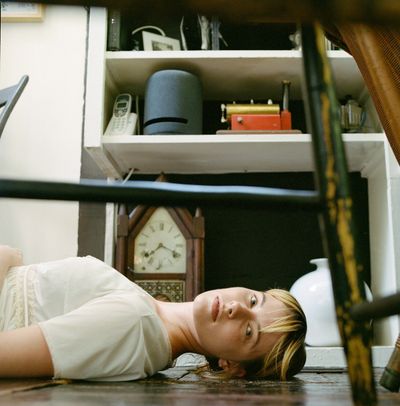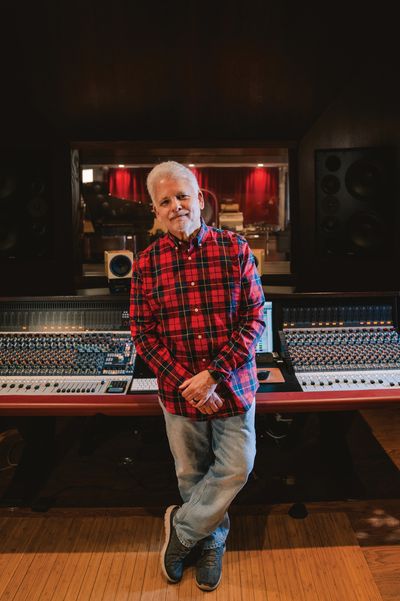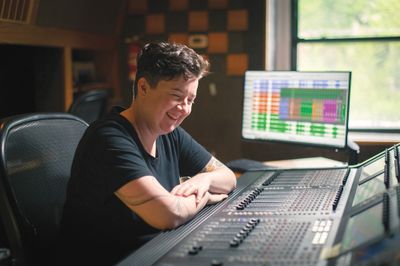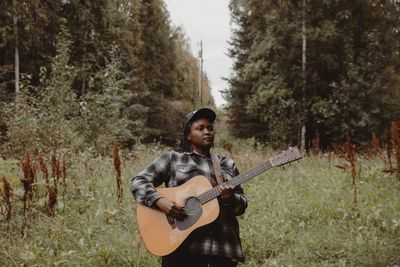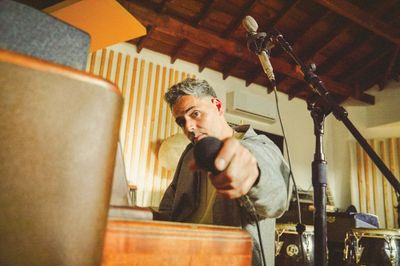We initially looked at the discontinued Tascam X-48 (standalone hybrid hard disk workstation) but it only has 48 inputs. Then we looked at the Tascam DA-6400 (digital multitrack recorder/player) for the capture, as it has 64 inputs and removable SDD drives that could capture over 14 hours per drive at 48 kHz/24-bit. After talking with Eric Larsen and Jeff Laity at Tascam, we settled on the DA-6400 as our capture unit and needed to sort out our front end. The DA-6400 uses MADI, AES/EBU, or Dante for inputs. After talking with our resident Gear Geek/reviews editor, Andy Hong, we felt that Dante made the most sense as it used Cat6 Ethernet cabling, making interfacing affordable, easy to run, and space efficient. Our next call was with Matt Pliskin at Focusrite, who helped us sort out the details and options of using their RedNet system. The great thing about the RedNet gear for our application was that the digital I/O for each unit was Dante on a single Cat6 connector.

Focusrite ended up supplying us with six RedNet 4 units, their 8-channel mic pres, and one RedNet 2 unit which has 16 analog line inputs and outputs. By now we had our rig, but we were missing one last piece of the puzzle; a redundant backup of the recording. As this was live we only had one shot at capturing all the performances, and we wanted to make sure we had two copies running in case of a drive issue or anything of that nature. Matt at Focusrite suggested we run a DAW in parallel off the Dante network. I'm most comfortable using Pro Tools, but unless we had an HDX rig – which we didn't have the budget for – we could only do 32 inputs in Pro Tools. Matt Suggested we look into Reaper [Tape Op #80] using Dante Virtual Soundcard as the audio engine, as there is no limit on the track count.
It was three days prior to the festival when all the equipment was in front of me. I had never used Dante or Reaper, and I had a bit of work and learning to do! The first step was to set up my Dante network with Dante Controller a free software application that senses all the devices on a Dante network and lets you route inputs and outputs between devices.

Besides the DA-6400, I had a 2015 era Mac Mini running Reaper that I was also using to set up the Dante network. The last two pieces of software in the system were RedNet control and Dante Virtual Soundcard (DVS). DVS is exactly what it sounds like, a piece of software that turns the Ethernet port of a PC into a Dante sound card. RedNet Control also does what you'd expect it to, control multiple RedNet devices over Ethernet. Focusrite also supplied us with a ten port Cisco SG300-10 Ethernet switch. All of my Dante connections went through the Cisco. The first seven ports were from the Focusrite RedNet units. Port eight went to the DA-6400. Port nine went to the Ethernet port on the Mac Mini, and via Dante Controller routed all 64 inputs into Reaper and the DA-6400. Once I got everything patched in, it was a simple process to route each of the Focusrite Red units' outputs in banks of eight to the DA-6400 and the Mac Mini, until I had all 64 outputs of the RedNet units showing up on the DA-6400 and in Reaper on the Mac. Lastly, I routed outputs one and two of Reaper to the first two outputs of the RedNet 2 unit and patched those into a Grace M903 [Tape Op #68] headphone amp and monitor controller, so I could monitor what we were recording. I had a fair bit of confidence in the Tascam DA-6400, but I was a bit skeptical about all 64 channels being routed into the Mac on a single Ethernet cable. To my surprise the combo of Dante Virtual Soundcard and Reaper worked flawlessly. With 56 tracks of audio in record mode at all times, the CPU usage in Reaper was at only 5%, which was very impressive! Using Reaper via Dante felt like I was driving a Ferrari and I barely got it out of first gear! You can rent DVS (as I did) for $9.95 for a 30-day license, but a full license is only $29.95. Reaper gives you a fully functioning 60-day license for free, and a full, perpetual license is only $60. Compared to DAWs that cost significantly more and can't record as many tracks, I was very impressed with the Reaper/DVS combo. I bought the full license of Reaper after the show, as I wanted to support them and would definitely use Reaper again. I'll also recommend it to clients who need a DAW that can handle high track counts and run efficiently. My only minor complaint with Reaper is that the documentation and support is limited, and I had a few learning curve glitches, but they all got solved in the end.

Finally, as third backup, Jesse wanted to get a feed of the front of house (FOH) mix and a backup of the audience mics to a separate 8-track recorder. I had hired engineer John Bologni, who does a lot of live recording, to help me out on the gig. He had recently purchased a used Tascam HS-P82 8-track recorder, so we had his rig at FOH taking a stereo mix from the FOH console along with our five audience mics.

So now that we had our plan, and everything was tested, we packed it all up and drove down to Monterey early Thursday morning, the day prior to the festival. Once there we met with Jesse's production partners and their 34-person crew at TourGigs. The film was being directed by renowned music photographer Danny Clinch and Jojo Pennebaker, the son of famed documentarian D.A. Pennebaker. D.A. had directed the original Monterey Pop film 50 years ago.
The live sound for the festival was provided by UltraSound, and everybody we interfaced with was super professional, friendly, and accommodating. Coincidentally the FOH house engineer, Dan Crowe, was an old friend of mine from Evergreen State College, who I hadn't seen for over 20 years. The last time we'd seen each other he was doing FOH and I was doing the recording of a ska festival at UC Berkeley's Greek Theatre in the '80s. I also ended up sitting next to the festival photographer, Jay Blakesberg, who I'd never met but also went to the same school as Dan and I. It was like a class reunion, as we had graduated in '82, '83, and '84 respectively.
Once on site we got the RedNet/Dante rig up and running in under an hour. Our five audience mics took several hours to get positioned and wired up, as we had splits on each mic that were running from FOH to stage and vice versa. I was glad to have John Bologni's help, as he has a lot of experience with live setups and gigs, and we were able to work pretty quickly and efficiently.

The five audience mics used a total of 15 cables that had to run between our rig, stage and FOH via various snakes and transformer isolated splits. After discussions with Jesse, we used two AKG 414s on the front of the stage in hypercardioid aimed out at the audience. At the FOH position we had two Neumann KM 184s as an ORTF pair, and we filled in the center image with a Blue B4 (their Neumann M 50 recreation, with a spherical omni capsule). We rigged up a cool single stand mount using a stereo mic bar, a Hook mic decoupler, and a shockmount.com mount. For our audience mics we had a 500 series rack with some nice vintage-flavored mic preamps; it seemed fitting for the retro vibe the festival was trying to recreate. The 414s went into a pair of the Realios (Helios-style) mic pres from Dave Amels and Greg Gualtieri. The KM 184s went into a pair of Skibbe Electronics' 736-5 pres (based on Flickinger pres). The B4 went through a CAPI Heider FD312 pre, which seemed fitting as the original festival had been recorded by the legendary Wally Heider.
As one last extra complication, we found out the day before the show that Father John Misty was bringing their own PA rig, and we had to pull a 10-channel stem mix from them. Wiring this up was a bit complicated, and used every last cable we had! With the extra stem mix channels from Father John Misty's set, we used 63 of the 64 available RedNet channels.
The 48-channel transformer isolated split from UltraSound went straight into the six Focusrite Red4 mic pres. This turned out to be a perfect choice. The Focusrites could handle anything that got thrown at them with lots of headroom and no noise. We were never quite sure what would come down the line, as we were underneath the stage and couldn't see what was happening except on the film crew's monitors. It was nice to have a mic pre that could handle whatever signal showed up and sounded great. Another excellent feature of the RedNet pres is that you can control all of them remotely from one screen via the RedNet Control app. This came in handy when a new set started and a mic was a bit too low, we could turn it up beyond our default of zero or prevent unexpected overloads. The sound coming off stage was all over the map, since there was no backline and each band had different gear and mics. We had no EQ on our end, as we were just aiming for a clean capture. But I finally got to hear how great the Focusrite mic pres sounded when The North Mississippi All Stars (with Luther and Cody Dickinson) started their set. The sound coming off stage from them sounded perfectly balanced and finished, and the RedNet pres captured it beautifully with detail and a very open soundscape. It was one of the best sounding sets of the weekend that hit our rig. Norah Jones brought her own system, and did her own multitrack recording, but the Jack Johnson and ALO sets were also sonically rewarding.

Monitoring through the Grace m903 gave us plenty of gain to hear a clean signal on headphones, even though we were directly underneath the loud stage.
At the end of each night we backed up all of our media with the film crew. The DA-6400 made this particular easy, as it has a removable drive caddy with a USB 3 connector. We gave it to the film crew, loaded a fresh caddy into the unit, and we were ready for the next day.
In the end, the biggest issue we had was sitting through 24 individual sets and not getting a bit stir crazy in the cave-like atmosphere under the stage. The rig worked perfectly, without a single glitch over the entire three-day festival, and I have to mention that this was the only time I've recorded 24 artists in three days! Jesse Lauter is mixing all the audio for the eventual release of the film. Keep an eye out for this soon-to-be-historic document!
montereypopfestival50.com
tourgigs.com
promediaultrasound.com
tascam.com/product/da-6400
us.focusrite.com/ethernet-audio-interfaces/rednet
gracedesign.com
reaper.fm
audinate.com/products/software ![]()
